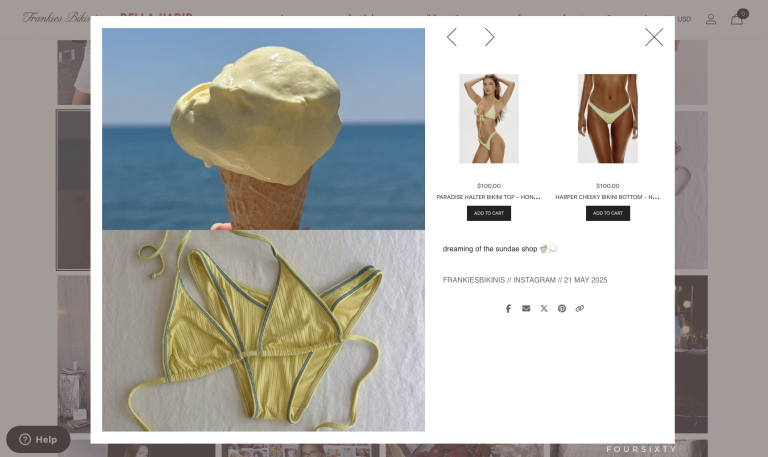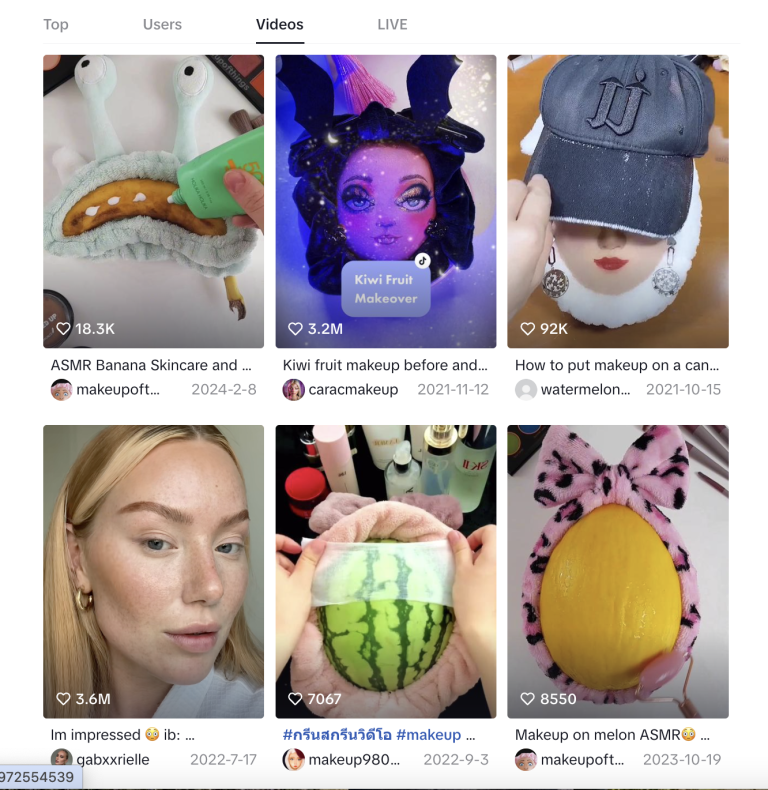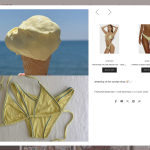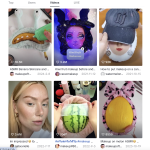User-generated content (UGC) refers to the photos, videos, and reviews where real customers share their experiences with your products.
UGC content is typically unpaid and shows up organically on platforms like Instagram, TikTok, and YouTube. It’s created not by influencers under contract, but by real-life users who genuinely love your brand.
In 2025, UGC is the internet’s version of word-of-mouth marketing.
People trust content from real people more than they trust ads. That’s why UGC can build trust, drive conversions with your content, and scale your brand story in ways traditional marketing just can’t.
In this guide, we’ll show you how to build a successful user-generated content strategy for your brand.
The Benefits of Implementing a UGC Strategy
Harnessing user-generated content as a marketing strategy delivers several benefits for your brand.
They include conversion rate improvements, authentic engagement, and higher community trust.
Let’s take a closer look.
Conversion Rate Improvements
According to a 2022 analysis of 1,200 ecommerce sites using UGC in marketing efforts, the average conversion rate was 3.2%, higher than the industry baseline of about 2%.
Plus, when these users engaged with UGC by clicking, scrolling, or expanding the content, they were twice as likely to make a purchase. This resulted in a 102.4% lift in conversion.
Pro tip: You can take this benefit even further with shoppable UGC, which contains direct links to the products it features. Shoppable videos, ads, and images tap into user trust and help drive conversions for your brand.
Authentic Engagement
User-generated content may feature your products, but it’s a form of peer-to-peer communication.
As noted in the California Management Review, “people tend to trust peer recommendations,” and “UGC enhances the credibility and effectiveness of campaigns by making them feel more personal and genuine.”
Using UGC as a form of content marketing encourages real conversations about your products, helping build both brand awareness and trust.
Community Trust
Word of mouth is the most trusted form of advertising, according to Nielsen’s 2021 Trust in Advertising Study. The study found that 88% of respondents trust recommendations from people they know more than any other form of advertising.
User-generated content works the same way. When real customers share photos, reviews, or videos about your brand, it feels more honest and relatable. That kind of content:
- Builds trust
- Creates a stronger connection with your audience
- Encourages others to join the community around your brand
- Helps drive purchasing decisions
Ready to put UGC to work for your brand?
Let’s get started!
How to Build Your UGC Strategy, Step by Step
Creating a successful UGC strategy involves more than reposting a few customer photos or reviews when the mood strikes.
For your UGC marketing campaign to succeed in driving conversions, engagement, and community, you need a plan.
Here’s how to build your UGC program from the ground up.
1. Identify Your Goals

Every good plan starts with clear goals.
Ask yourself this: What business outcomes do you want your UGC campaign to deliver?
The right answer will depend on your brand’s priorities and stage. But generally, businesses want one or more of these outcomes from a UGC strategy:
- Brand awareness: Increase visibility by encouraging customers to post and tag your brand.
- Trust: Strengthen the trust between your brand and your audience through real voices and customer experiences.
- Conversions: Use UGC in shoppable ads, social media posts, product pages, or emails to lower the barrier to entry for customers to make a purchase
- Community growth: Forge connections and brand loyalty with your target audience by spotlighting real customers.
- Social proof: Collect customer photos, reviews, or testimonials to strengthen your brand’s credibility.
If you’re anything like us, you probably want to achieve all these goals. And with a strong UGC strategy, you will!
But focus on just 1-2 main goals first. This helps keep your strategy from getting too overwhelming.
Look at your brand values and stage and align your goals accordingly.
Here’s a quick template to help you get started:
- Early-stage brand:
- Goal 1: Build brand awareness
- Goal 2: Collect visual social proof for product detail pages
- Growth-stage brand:
- Goal 1: Increase conversions
- Goal 2: Build community engagement
- Established brand:
- Goal 1: Strengthen trust and improve retention
- Goal 2: Reward people who consistently share content and use the UGC in paid ad campaigns
2. Select Channels and Formats
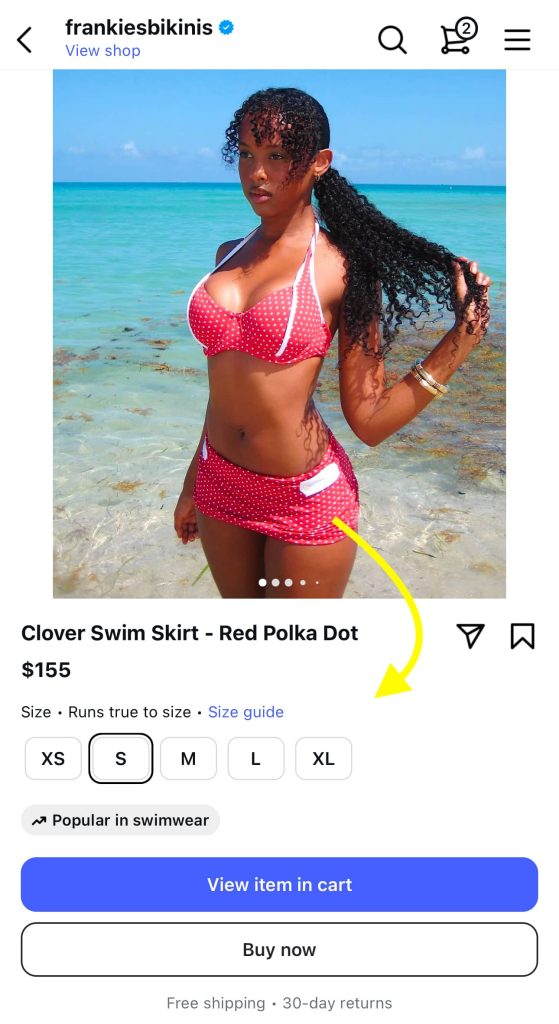
User-generated content appears on all sorts of social media platforms, from Instagram to YouTube. Not every platform is a perfect match for every brand, though.
Here’s a quick guide to some of the most popular UGC-friendly platforms and the types of content that shine on them.
- Best for: Branded hashtags, customer photos, Stories, Reels
- Ideal content: Lifestyle shots, product in-use photos and videos, UGC contests
- Why it works: Highly visual, easy to re-share content, ideal for community engagement
TikTok
- Best for: Short-form videos, behind-the-scenes, challenges
- Ideal content: How-tos, product hacks, funny/reactive/trendy content
- Why it works: Fast-growing, super popular, algorithm-friendly, great for reach
YouTube
- Best for: In-depth product reviews, unboxings, testimonials
- Ideal content: Longer-form UGC, expert reviews
- Why it works: Trusted for research, powerful for SEO
Your Website (product detail and landing pages)
- Best for: Visual reviews, quotes, video testimonials
- Ideal content: Curated UGC galleries, shoppable Instagram feeds
- Why it works: Builds trust at the point of purchase
Choose 1–2 priority platforms to start with. Before you make your final pick, though, ask yourself two key questions:
- Where is your target audience already sharing content?
- What kinds of content feel natural to those platforms and social media channels?
If your target audience is already posting content—and maybe even pictures of themselves using your products!—on Instagram, you should be there too. If they seem more invested in TikTok, it’s time to create a TikTok brand profile.
3. Find and Motivate UGC Contributors

Even though it would be amazing if customers always created epic UGC on a schedule, it’s not quite that easy.
It takes a little bit of elbow grease, but finding and motivating UGC contributors is also totally doable.
Keep these three points in mind: you must make it easy, rewarding, and worthwhile for your customers to participate.
The first step is to find willing participants. Look for your happiest, most satisfied customers. These are the people who are already tagging you, leaving customer reviews, or posting photos and video content featuring your products, unprompted.
Grab public-facing contact information (like Instagram handles) from your:
- Loyal repeat buyers
- Positive reviewers
- Social media followers who regularly engage with your posts
- Brand ambassadors, content creators, or affiliate partners
Pro tip: Tools like Foursixty (that’s us!) can find and round up all the best UGC your brand is already tagged in to make this step a whole lot easier.
Next, it’s time to get these customers excited about sharing quality content. Customers are more likely to share UGC if they see a clear reason to do it.
This doesn’t mean you have to offer money, or even incentives. Try:
- Creating a branded hashtag and featuring the best posts
- Running a monthly giveaway for tagged posts
- Offering points or perks through your loyalty program
- Sending a follow-up email asking for a photo or review
- Highlighting top contributors in your newsletter or on your site
People love to be seen. When you show that you value and celebrate their content, they’re far more likely to share, again and again.
4. Moderate the Content
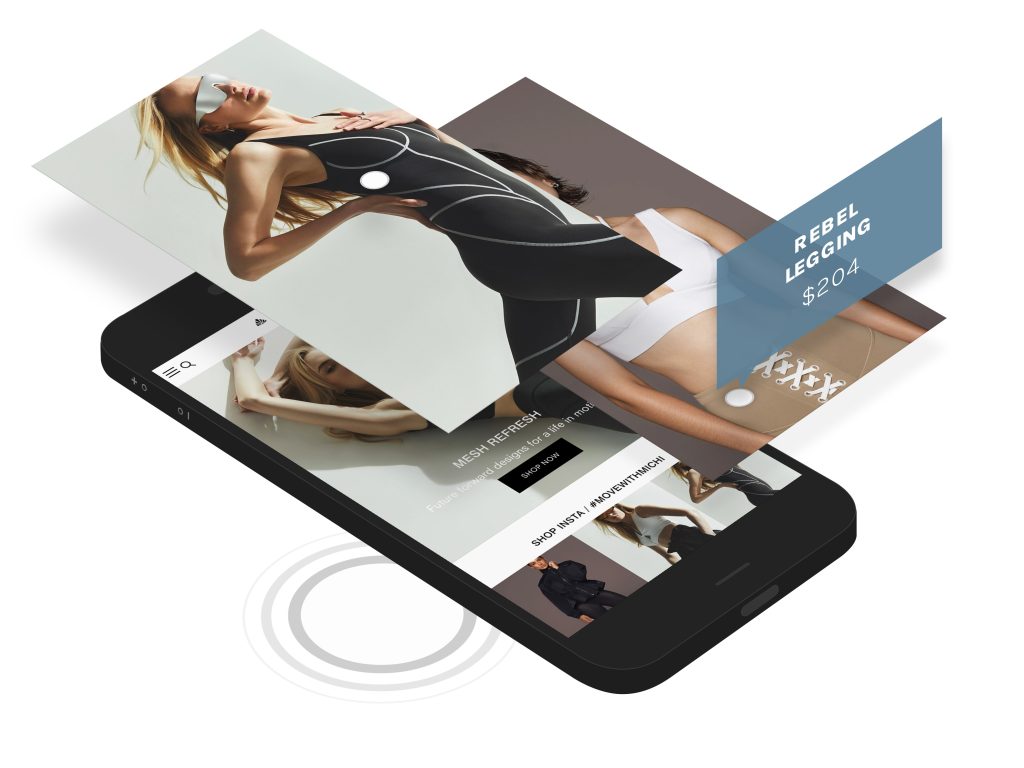
Not all user-generated content is on-brand, high-quality, or even safe to use. That’s why moderation is an essential step of a user-generated content strategy.
The goal here is to highlight the best content and make sure you have permission to use it.
Start by setting crystal-clear content guidelines for your team.
Focus on sourcing UGC with:
- High-resolution videos or images
- Positive sentiments toward your product and brand
- Prominent product placement
- Audience-friendly messaging (no inappropriate content, for example)
Then, use moderation tools to review and manage submissions.
At Foursixty, we have a tool that lets you request the rights to use UGC for marketing purposes with just one click.
This helps you stay legally compliant.
Here’s why UGC rights management matters. Even if a customer tags your brand or uses your hashtag on Instagram posts, that doesn’t automatically give you legal permission to republish their content.
This is especially true if you plan on making money with UGC through ads, emails, or product pages.
When you make sure to secure the rights to the content, you can have peace of mind.
If you’re managing submissions manually, make sure you meticulously document all the permissions you receive. You’ll also need to create a system for flagging inappropriate or off-brand content.
5. Publish and Promote Your UGC

Once you’ve curated and secured the best content, it’s time to put it to work.
This is the fun part!
Create a calendar to share user-generated content across your most important touchpoints. These include:
- Social media: Reshare to your main feed, Stories, or Reels with proper credit. Even better, make those posts shoppable!
- Product detail pages (PDPs): Use customer lifestyle product photography and reviews to boost trust at the point of purchase.
- Email marketing: Highlight top contributors in email campaigns or use user-generated content to support product launches.
- Paid ads: Repurpose top-performing UGC into shoppable social ads. (Hint: Shoppers are more likely to trust authentic, user-created content than brand-created ads. It’s the power of social proof, folks!)
Finally, make sure you thank and tag users when you feature their content. They’ll appreciate the recognition and be more likely to keep contributing UGC in the future.
6. Measure Performance

Your user-generated content strategy shouldn’t stop at the posting and sharing stage.
There’s one more step to think of, and that’s making sure your strategy is doing what you want it to do.
Remember the goals you outlined in Step 1?
Once you begin putting your UGC into action, go back to those goals and track key metrics accordingly.
Here’s what we mean:
- If your goal is conversions: Track click-through rates (CTR), add-to-cart, and purchase rates on UGC-rich product detail pages.
- If your goal is brand awareness: Monitor your reach, impressions, and engagement on social media UGC posts.
- If your goal is trust/social proof: Look at survey feedback, the number of reviews you get, and how often content gets saved or shared. These metrics show how much people trust and relate to your brand.
The bottom line? Look at what’s working and do more of it. If something isn’t working, tweak and adjust until it is.
This step is where the benefits of user-generated content really shine. The more you pay attention to optimization and improvement, the more relevant your UGC can be for your potential customers.
Examples of Great UGC Strategies
At Foursixty, we’re passionate about helping brands turn UGC into a customer engagement and conversion tool.
In these case studies, find out how we helped companies turn authentic content into a powerful driver of trust, community, and—you guessed it—sales.
Pura Vida: Transforming UGC into a Revenue Engine
The Challenge: Pura Vida Bracelets wanted to harness the power of their vibrant community. To do this, they wanted to weave authentic UGC into their ecommerce experience.
The Solution: Using Foursixty, Pura Vida curated and displayed UGC throughout their website, including:
- Homepage gallery
- Product page gallery
- Email newsletter gallery
- Shopify Shop Mini gallery
This strategic placement of UGC gave—and continues to give—customers the opportunity to see the products in real life as they browse, shop, and make purchasing decisions.
The Results: Pura Vida’s integration of Foursixty led to significant improvements, including:
- 17% of online revenue attributed to Foursixty conversions
- 18.2% of sessions engaging with Foursixty galleries clicked through to the point of sale
- 73% increase in page views for the Pura Vida website
Read the full Pura Vida case study here.
MICHI: Showcasing Innovative Sportswear with Shoppable UGC
The Challenge: MICHI, an innovative activewear brand, wanted to use UGC to show off their products in real-life situations.
The Solution: In just half a day, the team at Foursixty helped MICHI showcase UGC in three places:
- Homepage gallery
- Product page gallery
- Full-page Instashop gallery
The Results: With an increase in highly interactive content on their site, MICHI has enjoyed these benefits of a UGC strategy:
- 51x increase in ROI after just 30 days of starting their UGC campaign
- 4,800 products tagged with Foursixty
- 26% increase in visitor interaction on their site
Real UGC, Real Conversions, Powered by Foursixty
Looking to turn UGC into actual revenue?
At Foursixty, we’ve helped brands like Pura Vida Bracelets, MICHI, Kylie Cosmetics, SKIMS, and hundreds more implement UGC strategies.
From sourcing tagged content and securing rights to creating shoppable galleries and tracking analytics, Foursixty offers the full toolkit your team needs for a winning UGC strategy.
Want to see how Foursixty can help you put your UGC strategy to work? Start your free trial today.
FAQs
What is a good example of UGC?
A good example of user-generated content (UGC) is when real customers post social media content showing how they use your new products. This can include things like social media posts, unboxing videos, reviews, or styling tips. The key? Your brand gets tagged in this content.
Brands like MICHI and Pura Vida use UGC in shoppable ads and across social networks to increase engagement and conversions.
With the help of shoppable content platforms, they also add shoppable content to their websites. This turns something as simple as a real customer post into clickable, conversion-driving asset.
For inspiration, browse other shoppable content examples that show how real people use a product in everyday life.
How do I create a UGC strategy?
To create a successful UGC strategy, start by identifying your goals: do you want to grow brand reach, increase sales, or build trust?
Then, choose your types of UGC — such as reviews, photos, videos, or influencer collabs — and map out your content creation plan. Tools that support social media management and partnerships with UGC creators can help streamline the process.
Finally, think about distribution. Will you feature UGC in emails, Shoppable Ads, or on your site using shoppable content platforms?
Make sure you measure the ROI of shoppable content to help you refine your strategy and prove its value.
How can I encourage customers to create user-generated content?
The best way to encourage UGC is to make it rewarding and easy. Launch a branded hashtag campaign, for example, or feature customer content in your feed. Highlight top contributors as brand advocates to get the excitement going.
You can also collaborate with UGC creators to build momentum for your brand. Incentives like giveaways or early access to new products can help people want to get involved.
Make sure your social media content invites customers to engage, and use your social media management tools to track and reshare submissions. The more visible and appreciated your fans feel, the more likely they are to contribute.


